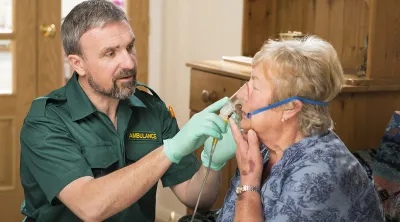A new model for emergency medical services: treat patients at home

Highmark Blue Cross Blue Shield (Highmark BCBS) seized an opportunity to work with ambulance companies in the region to improve patient care, reduce member out-of-pocket costs and avoid unnecessary trips to the emergency room. Ambulance companies in the region were intrigued but wondered how avoiding trips to the emergency room would be financially viable for them. Most insurance companies only reimburse ambulance companies for transporting a patient to the hospital – not for providing care at home. But emergency medical teams are highly trained and capable of addressing multiple health problems at home. Couldn’t they be reimbursed for that kind of care – and help a patient avoid an unnecessary trip to the ER – too?
A new financial model, a break with tradition
A groundbreaking Highmark BCBS pilot with a dozen regional ambulance companies is testing that model.
Highmark BCBS will reimburse ambulance companies to care for patients with specific conditions at home. If a patient wants or needs to go the ER, ambulance companies will transport them immediately. But if a patient agrees to try treatment at home, an emergency medical team can use evidence-based treatment to manage their symptoms on site and arrange for any follow up care. Patients will receive the same high-quality care and pay less for it because they won’t owe out of pocket costs for an expensive ambulance trip.
The program sounds simple enough, but it’s a break with tradition, says Bob Wanovich, vice president for ancillary provider strategy for Highmark BCBS. There are just a handful of places trying this model, he says, “but that’s still rare and very new.” Medicare, for example, is only now just considering a similar program.
Emergency medical teams can do more than “give rides”
Robert McCaughan, who oversees ambulance operations for Allegheny Health Network, a network of hospitals in Pittsburgh, Penn., knows both sides of the ambulance business equation. He used to be chief of emergency medical services for the city of Pittsburgh, which handles 911 calls. And when someone calls 911, the ambulance company that responds is obligated to take that person to the hospital, unless the patient refuses.
But throughout his time on the job, McCaughan noticed something. “Every day, ambulances took a patient to the hospital who probably could have been treated in their home,” says McCaughan.
Why not provide the care patients needed at home, he thought, if a trip wasn’t necessary?
Why not save them any out-of-pocket costs for that ambulance service – costs that could soar over a thousand dollars?
“There’s a benefit for everybody,” he says. “First and foremost is for the patient. We always want to see the patient get the right care, at the right time, at the right place.”
Emergency medical crews benefit, too. They may have the opportunity to practice at the top of their licenses, which means getting to use even more of their extensive training to help patients.
Safely treating patients at home
Under the pilot, if patients have three conditions – diabetes, asthma or seizure disorder – ambulance crews can offer them in-home care. During the visit, paramedics will assess the patient, develop a treatment plan and confirm that plan with an on-call physician. Once the patient is stable, says McCaughan, paramedics will ask patients if they still want to go to the hospital. If not, that decision will be cleared by the on-call physician, and the ambulance crew will leave behind educational material outlining what to do if symptoms reoccur. Within 48 hours, the patient will receive a follow-up call and an offer to be connected to a primary care physician if needed.
Better care and fewer unnecessary ER visits
Highmark BCBS’ Bob Wanovich sees the project as providing better care – and a better experience – for patients. Wanovich also sees an opportunity to free up beds and staff time for patients with more serious needs in emergency rooms.
Measuring success
Wanovich says Highmark BCBS will be tracking results over 2019 to determine whether the program is helping patients stay healthier and reducing costs. Key data Highmark BCBS is gathering include:
- The number of ambulance responses and how many times a transport to the emergency department was avoided, if unnecessary
- The cost of the program versus the cost of emergency room visits
- Analysis of how the pilot might improve or expand
“Our hope is that, as we gather data and prove the success of the pilot,” says Wanovich, “other insurers will look and say ‘this is the right thing to do.’”
Highmark Blue Cross Blue Shield is an independent licensee of the Blue Cross Blue Shield Association, an association of independent, locally operated Blue Cross and Blue Shield companies.
